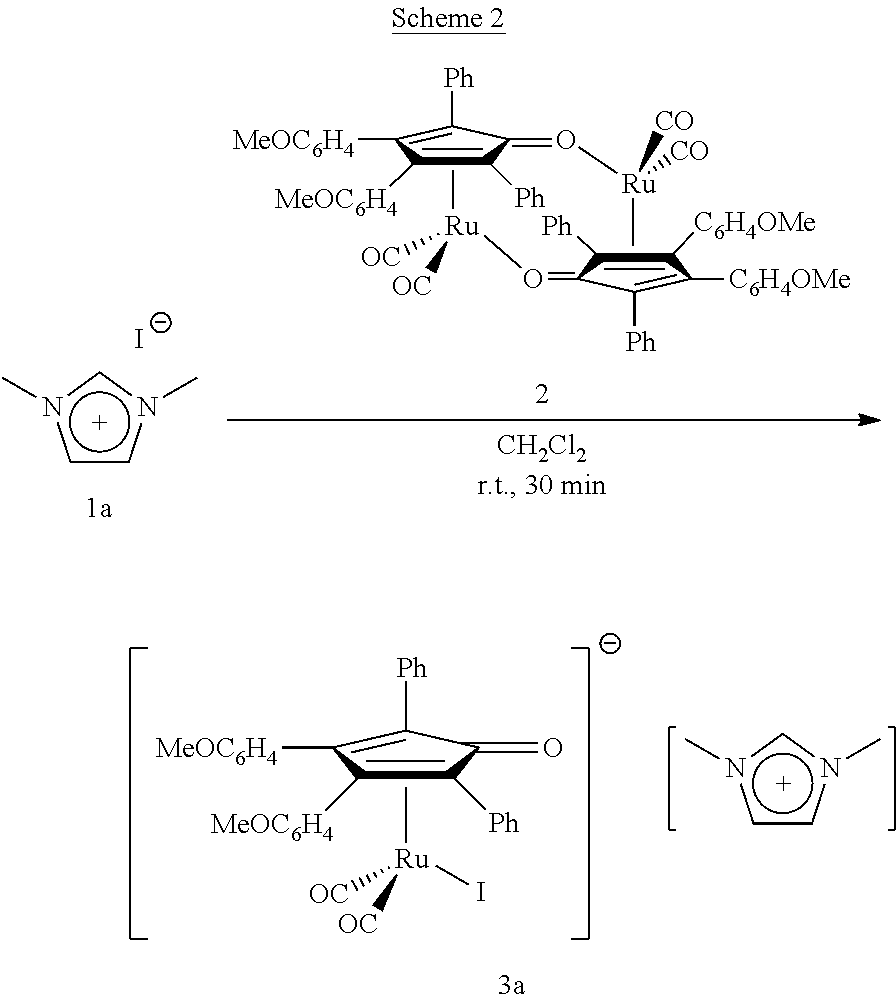Process for the transformation of primary aliphatic alcohols into higher aliphatic alcohols
- Summary
- Abstract
- Description
- Claims
- Application Information
AI Technical Summary
Benefits of technology
Problems solved by technology
Method used
Image
Examples
example 1
of a Ruthenium Complex
[0079]With reference to the following Scheme 2, 0.037 g of 1,3-dimethylimidazolium iodide (compound 1a in Scheme 2, 0.166 mmol) were reacted with 0.100 g (0.083 mmol) of dicarbonyl(η4-3,4-bis(4-methoxyphenyl)-2,5-diphenylcyclopenta-2,4-dienone) ruthenium dimer (compound 2 in Scheme 2) in a solution of CH2Cl2.
[0080]The reaction mixture was left under stirring at room temperature for 30 minutes.
[0081]By precipitation with a dichloromethane / n-hexane mixture, a yellow solid was obtained, identified as [dicarbonyl(η4-3,4-bis (4-methoxyphenyl)-2,5-diphenylcyclopenta-2,4-dienone)(iodine)ruthenium][1,3-dimethylimidazolium](Complex 3a in Scheme 2).
[0082]Complex 3a is stable to air, humidity and dissolved in a solution of non-anhydrous organic solvents.
[0083]Analysis by infrared spectroscopy, proton NMR analysis (1H-NMR), carbon NMR analysis (13C-NMR), mass spectroscopy analysis (ESI-MS), and elemental analysis confirmed the formation of the Complex 3a. The results of th...
example 2
rocedure for the Conversion of Ethanol to n-Butanol and Higher Alcohols
[0090]With reference to Scheme 3 below, a 6 mL Schlenk was loaded with 14 mg of the ruthenium complex (Complex 3a in Scheme 2, 0.0172 mmol) synthesized in the previous example (Example 1), with a suitable amount of sodium ethoxide (NaOEt, 122 mg, 1.72 mmol) and with a suitable amount of additive (2,6-dimethoxybenzoquinone, 22 mg, 0.129 mmol).
[0091]Subsequently, 0.5 mL of ethanol (8.6 mmol) were added under inert atmosphere to the reaction mixture (the amount of Ru complex on the reagent is 0.2% molar).
[0092]Then, the resulting suspension was heated at 150° C. for 4 hours.
[0093]At the end of the reaction, the mixture was cooled to room temperature and then stored for 10 minutes in the refrigerator (temperature 4° C.).
[0094]Finally, the mixture was diluted with 3 mL of Et2O and 162 μL of THF were added as an internal standard. The resulting mixture was analyzed by gas chromatography and gas chromatography interface...
example 3
[0099]The procedure reported in the Example 2 above was repeated varying the type of the used base.
[0100]The following Table 2 shows the molar amounts of the base, and of the additive with respect to the alcohol, as well as the reaction temperature and the reaction time, the ethanol conversion rate, the n-butanol yield, the total yield in alcohols, and the calculated carbon loss (loss); at first row, the results of Example 2 are given by way of comparison, at second and third rows, the results obtained using sodium hydroxide and sodium methoxide are respectively given.
TABLE 2Alco-EtOHBuOHholsBaseAdd.TtConv.yieldyieldLossBase(%)Add.(%)(° C.)(h)(%)(%)(%)(%)NaOEt20A1.5150472.137.561.011.1NaOH20A1.5150482.832.859.623.1NaOMe20A1.5150479.627.258.321.2A = 2,6-dimethoxybenzoquinone
[0101]The results show that sodium hydroxide and sodium methoxide are also good candidates as bases to be used in the process of the invention, with particular attention to sodium hydroxide.
[0102]In particular, hi...
PUM
| Property | Measurement | Unit |
|---|---|---|
| Temperature | aaaaa | aaaaa |
| Temperature | aaaaa | aaaaa |
| Fraction | aaaaa | aaaaa |
Abstract
Description
Claims
Application Information
 Login to View More
Login to View More - R&D
- Intellectual Property
- Life Sciences
- Materials
- Tech Scout
- Unparalleled Data Quality
- Higher Quality Content
- 60% Fewer Hallucinations
Browse by: Latest US Patents, China's latest patents, Technical Efficacy Thesaurus, Application Domain, Technology Topic, Popular Technical Reports.
© 2025 PatSnap. All rights reserved.Legal|Privacy policy|Modern Slavery Act Transparency Statement|Sitemap|About US| Contact US: help@patsnap.com



